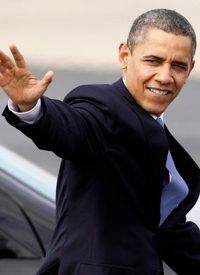
To purportedly tame the progressive rise in gas prices, President Obama visited a North Carolina truck manufacturer on Wednesday to unveil a new $1 billion plan to advocate electric and alternative vehicles through consumer incentives and federal grants for states.
The “green” initiative, tagged the “National Community Deployment Challenge,” provides a $10,000 tax credit — up from the current $7,500 incentive — to consumers purchasing “advanced cars and trucks.” The grant program includes a “Race to the Top” contest that would award money to states with “model communities” that agree to fund infrastructure such as charging stations or natural gas corridors “where alternative fuel trucks can transport goods without using a drop of oil,” according to the White House Press Fact Sheet.
The company that Obama visited on Wednesday is Daimler Trucks North America, a cohort of the Energy Department’s SuperTruck initiative, which intends to boost fuel efficiency of 18-wheel, long haul trucks by 50 percent by 2015. In a speech at the North Carolina plant, the President affirmed:
Here is the truth. If we are going to control our energy future, then we’ve got to have an all-of-the-above strategy. We’ve got to develop every source of American energy — not just oil and gas, but wind power and solar power, nuclear power, biofuels. We need to invest in the technology that will help us use less oil in our cars and our trucks, in our buildings, in our factories. That’s the only solution to the challenge. Because as we start using less, that lowers the demand, prices come down. It’s pretty straightforward. That’s the only solution to this challenge.
Obama chose the Daimler Truck plant for his announcement because alternative fuel vehicles are currently being manufactured there. He also heralded the 1,000 new employees that the company recently hired. “You’re not just building trucks,” he proclaimed to a crowd of workers. “You’re building better trucks that use less oil.”
Environmental groups and industry advocates have hopped on the alternative-vehicle bandwagon, touting Obama’s new program as a groundbreaking initiative that will protect the environment and ease U.S. dependence on foreign oil. “By accelerating deployment of alternative-fuel trucks and making electric vehicles more economical, these new initiatives will expand the benefits to our wallets, to our economy and our environment,” asserted Luke Tonachel, a vehicles analyst for the Natural Resources Defense Council.
Other proponents blame U.S. oil dependence for empowering hostile regimes like Iran. “While there is no silver bullet to break oil’s grip on our national security, we do have silver buckshot in our arsenal: the enterprise and innovations to develop clean, domestic energy sources that will reduce our dependence on oil and ensure America’s national security,” said Mike Breen, vice president of the Truman National Security Project. “That is why I commend the White House for today’s proposal that they will allocate $1 billion for the development of a broad range of alternative fuels and vehicle technologies and the infrastructure need to deliver those alternatives to the consumer.”
But CEO of the American Petroleum Institute Jack Gerard says this purported “all-of-the-above” approach disregards the development of oil and gas, as he affirmed in a statement Wednesday before the House Committee on Energy and Commerce:
The administration says it is for more oil and gas, but rejects the Keystone XL pipeline. It says it is boosting domestic production onshore, but new leasing on federal lands is down 44 percent, and the number of new wells drilled is down 39 percent. It says it is opening offshore areas but the latest plan keeps 87 percent of these areas off limits. It says oil and gas activity in the Gulf of Mexico is back to normal, but the latest forecast says production this year will be down nearly 21 percent from 2010. It says it is for natural gas, but 10 federal agencies are looking at new regulations that could needlessly restrict it. It calls for “all-of-the-above” then threatens the companies that could lead an energy renaissance with $85 billion in discriminatory tax increases.
The President’s initiative comes at a delicate economic time, as gas prices spike to record levels. The cost of regular fuel has sprung above $4 a gallon in many cities around the country, and Republican presidential candidates are now pouncing on the opportunity to exploit this nationwide trend.
The federal government has already sunk millions of dollars into the electric car market, but Washington continues to pedal the gas for more. In his 2011 State of the Union Address, Obama pledged to “break our dependence on oil” and vowed to “become the first country to have one million electric vehicles on the road by 2015.” But so far, the President’s emphatic drive to electrify America’s roadways has been futile. General Motors’ Chevy Volt, the poster child for the administration’s green-energy advocacy, has suffered from floundering sales — which, in turn, has forced the automaker to halt production of the electric car earlier this month.
One might suggest that the government should retract itself from the alternative-car industry and allow the market to determine the winners and losers of technological development. And in the meantime, to abate the rising burden at the pump, the laws of supply and demand dictate that the government should lift restrictions on domestic oil production and approve the Keystone XL pipeline.
Photo: President Barack Obama waves at the crowd as he leaves for a North Carolina truck manufacturing plant after arriving at the North Carolina Air National Guard Base in Charlotte, N.C., March 7, 2012.: AP Images



